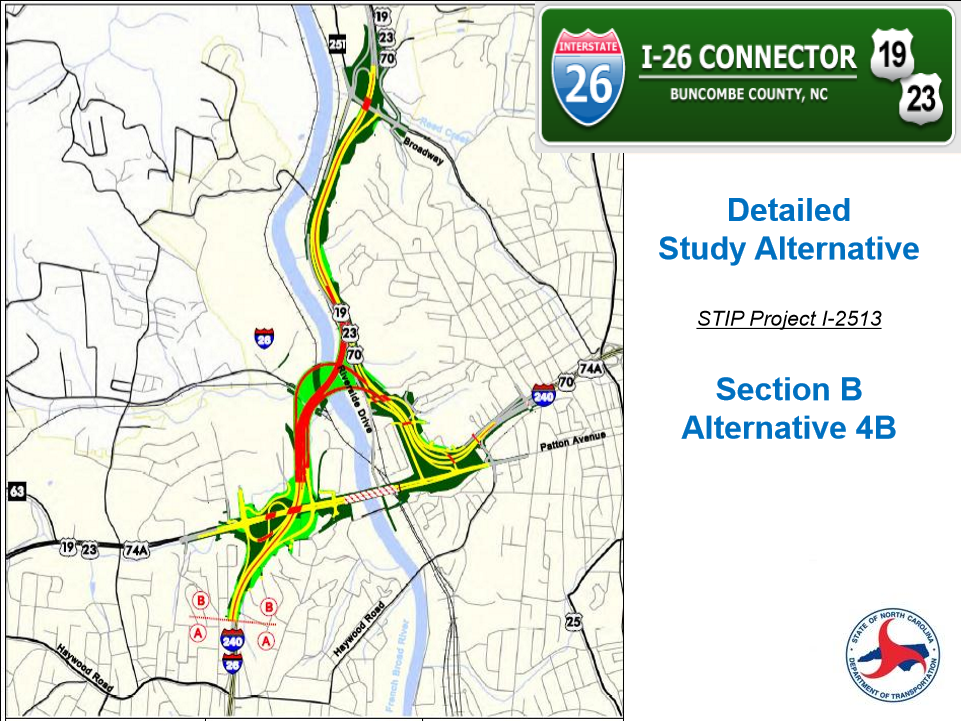A North Carolina Department of Transportation engineer told a group of independent businesses owners Friday, Jan. 10, that upcoming hearings could lead to construction on Asheville’s Interstate 26 connector project starting in 2020.
Construction engineer Ricky Tipton gave the Council of Independent Business Owners a presentation on the current status of the controversial connector project along with a tentative schedule for work on Asheville’s highway system.
The project, an ongoing topic of interest in the area since the early 1990s, deals with the section of I-26 between urban Asheville and Mars Hill that does not meet interstate standards. I-26 connects Charleston, S.C., with Kingsport, Tenn., and Interstate 81, providing a crucial route for incoming and outgoing freight at the ports of Charleston and Savannah. Vehicles traveling north on I-26 have to cross the connector between Asheville and Mars Hill. Traffic is routed partially through downtown on Interstate 240 over the Jeff Bowen Bridge. That leads to excessive wear and tear on vehicles, as well as congestion and accidents on the downtown Asheville roadway. The project has been a major topic of debate over the years, with critics saying the cost and damage to surrounding neighborhoods of some plans is too high and calling for alternative plans.
CIBO members have long supported the state’s less expensive designs for the connector and have called for construction to get started sooner rather than later.
“We definitely have a problem on that bridge and that section,” says North Carolina Board of Transportation member David Brown, as he lists the five state criteria for determining fund allocation, one of which is “congestion.” “In my office I can look out at least four times a week and see the traffic backed up to the Merrimon Avenue ramp because there’s been some accident in that area.”
Brown says an estimated 110,000 vehicles per day cross the Jeff Bowen Bridge, and this number could drastically be reduced if an alternate connector route were to be constructed to remove interstate through-traffic from the local I-240 downtown expressway.
“It’s not really designed for that, and it’s over capacity,” Brown says about the bridge.
“DOT got started this month putting all the figures together as far as trying to determine what the prioritization [statewide] will be,” Brown says. “We actually should know how it competes by the other projects in the state by the first part of the spring — and that’s going to be very interesting. But we rate very highly on a lot of the criteria.”
“The existing connection between US 19-23 [the future I-26 connector] from the north and I-240 follows sharply curved, single-lane ramps that do not meet the design requirements for an interstate freeway,” according to NCDOT.gov.
The specific Asheville connector project is fourfold:
• To “provide an interstate connection through Asheville to safely accommodate the expected volumes on I-26.”
• To “improve the capacity deficiencies of the existing I-240 crossing of the French Broad River.”
• To “reduce traffic delays and congestion along I-240 at the crossing of the French Broad River.”
• To “increase the remaining useful service of the Jeff Bowen Bridge.”
Tipton’s presentation listed the tentative schedule for the project, with a citizen’s informational workshop to be held in this spring and a public hearing. Further down the road, his schedule marked a right of way to be held in late 2018 and the first construction letting in late 2020.
There are currently two proposed construction alternatives to the section of roadway marked “B” to be considered. “The two alternatives we’re looking at is [alternative] 3 in section B, and that’s $251 million dollars,” says Brown. “And alternative 4B is $332 million.”

Alternative 3 would cost $251 million.

Alternative 4B would cost $332 million.
Alternative “[4B] has a lot of extensive bridging. It’s a pretty extensive project,” Tipton added as he showed a computer-simulated video of the proposed changes in each of the alternatives, showing where the extra $81 million comes in. Both alternatives call for the interstate to dip under Patton Avenue.
The section of I-26 just north of Mars Hill was completed to interstate standards in 2004, and it is the first section of the road to meet Interstate regulations north of Asheville. Other interstate projects are in the works as well, including road widening and improvements north of Asheville and in Southern Buncombe County and Haywood County—making the combined projects total “a billion dollars in highway work,” says Brown.
“There’s nothing the community can do except get behind one of the specific alternatives,” Brown says, answering a question on what the community can do to help get the I-26 connector project higher on the state’s priorities list.




Before you comment
The comments section is here to provide a platform for civil dialogue on the issues we face together as a local community. Xpress is committed to offering this platform for all voices, but when the tone of the discussion gets nasty or strays off topic, we believe many people choose not to participate. Xpress editors are determined to moderate comments to ensure a constructive interchange is maintained. All comments judged not to be in keeping with the spirit of civil discourse will be removed and repeat violators will be banned. See here for our terms of service. Thank you for being part of this effort to promote respectful discussion.